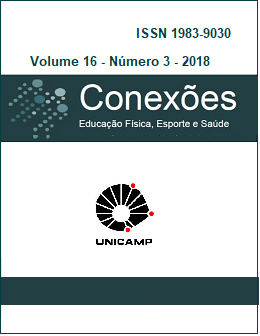Abstract
The aim of the study was to compare levels of perceived stress and quality of life among regular and
irregularly active jiu-jitsu practitioners. The sample consisted of 50 individuals, being: 25 regular jiujitsu practitioners, with 6 female participants and 19 male participants, mean age of 31.76±8.25 years,
practice time of 78±83.04 months, practicing 3.48±1.61 days per week, with mean duration of each
session of 98.40±26.72 minutes and duration of 356.4±215.35 minutes of training per week and 25
irregularly active, with 10 female participants and 15 male and mean age of 32.08±10.38. The
WHOQOL-Bref and Perceived Stress Questionnaire (QEP) instruments were used, as well as
questionnaires for characterization of the sample. Analyzing the WHOQOL-Bref instrument, a
significant difference was found only in the physical domain, with better results found in Jiu-Jitsu
practitioners. Regarding the results of the QEP, there was a significant difference in the areas of
irritability, tension and fatigue, energy and joy, and general result, evidencing that jiu-jitsu
practitioners tend to have a lower level of stress when compared to irregularly active ones.
References
ACSM - AMERICAN COLLEGE OF SPORTS MEDICINE. Reducing Sedentary Behaviors: sit less and move more. American College of Sports Medicine, 2016. Disponível em: https://pt.scribd.com/document/340996130/reducing-sedentary-behaviors-sit-less-and-move-more-pdf. Acesso em: 02 mai. 2017.
BARBANTI, Eliane Jany. Eficácia do exercício físico nos sintomas de pacientes com depressão. Educação Física em Revista, Brasília, v. 6, n. 3, p. 1-13, dez 2012. Disponível em: https://portalrevistas.ucb.br/index.php/efr/article/view/3595. Acesso em: 18 out. 2017.
BENEDITTI, Eliana; OLIVEIRA, Roseli Lage de; LIPP, Marilda Emmanuel Novaes. Nível de stress em corredores de maratona amadores em período de pré-competição. Revista Brasileira de Ciência e Movimento, Brasília, v. 19, n. 3, p. 5-13, 2011. Disponível em: https://portalrevistas.ucb.br/index.php/RBCM/article/view/2147/2035. Acesso em: 20 jan. 2017.
BRANDT, Ricardo et al. Humor pré-competitivo em atletas brasileiros de jiu-jitsu. Caderno de Educação Física e Esporte, Marechal Cândido Rondon, v. 13, n. 1, p. 21-30, jun. 2015. Disponível em: http://e-revista.unioeste.br/index.php/cadernoedfisica/article/view/13817. Acesso em: 14 jan. 2017.
BU, Bin. et al. Effects of martial arts on health status: A systematic review. Journal of Evidence-Based Medicine, China, v. 3, n. 4, p. 205-219, nov. 2010. Disponível em: https://www.ncbi.nlm.nih.gov/pubmed/21349072. Acesso em: 05 mar. 2017.
CID, Luís; SILVA, Carlos; ALVES, José. Actividade física e bem-estar psicológico - perfil dos participantes no programa de exercício e saúde de rio maior. Revista Motricidade, Portugal, v. 3, n. 2, p. 47-55, abr. 2007. Disponível em: http://www.redalyc.org/articulo.oa?id=273020548010. Acesso em: 16 out. 2017.
CBJJE - Tabela de peso oficial CBJJE. Confederação Brasileira de Jiu-Jitsu Esportivo, 2017. Disponível em: http://cbjje.com.br/gespress/uploads/2016/01/Tabela-de-Peso-Masculina-20172.pdf. Acesso em: 10 out. 2017.
DALL’AGNOL, Cristiano; SILVA, Rodrigo Del Ponte; DEL VECCHIO, Fabrício Boscolo. Quality of life of male amateur athletes from Pelotas, Brazil. Revista Brasileira de Atividade Física e Saúde, Londrina, v. 22, n. 2, p. 147-154, 2017. Disponível em: https://periodicos.ufpel.edu.br/ojs2/index.php/RBAFS/article/view/8738. Acesso em: 11 out. 2017.
DESLANDES, Andréa Camaz et al. Exercise and Mental Health: Many Reasons to Move. Karger Journal, v. 59, n. 4, p. 191-198, jun. 2009. Disponível em: https://www.karger.com/Article/Abstract/223730. Acesso em: 11 out. 2017.
FLECK, Marcelo Pio de Almeida et al. Aplicação da versão em português do instrumento abreviado de avaliação da qualidade de vida “WHOQOL-bref”. Revista de Saúde Pública, São Paulo, v. 34, n. 2, p. 178-183, abr. 2000. Disponível em: http://www.scielo.br/pdf/rsp/v34n2/1954.pdf. Acesso em: 17 mai. 2017.
HIGA, Lucas. et al. Nível de estresse entre sedentários e praticantes de atividade física de diferentes modalidades. Revista Brasileira de Ciência e Movimento, Brasília, v. 22, n. 4, p. 22-26, 2014. Disponível em: https://portalrevistas.ucb.br/index.php/RBCM/article/view/4736. Acesso em: 15 ago. 2017.
LAMOUNIER, Gislaine Helena da Silva. Sedentarismo e qualidade de vida. 2012. 38 f. Monografia de Conclusão de Curso (Especialização em Atenção Básica em Saúde da Família) - Universidade Federal de Minas Gerais, Belo Horizonte, 2012.
LEVENSTEIN, Susan et al. Development of the perceived stress questionnaire: a new tool for psychosomatic research. Journal of Psychosomatic Research, Great Britain, v. 37, n. 1, p. 19-32, jan. 1993. Disponível em: https://www.ncbi.nlm.nih.gov/pubmed/8421257. Acesso em: 02 mar. 2017.
NAHAS, Markus Vinicius. Atividade física, saúde e qualidade de vida: conceitos e sugestões para um estilo de vida ativo. 2. ed. Londrina, PR: Midiograf, 2001.
PEDROSO, Bruno et al. Cálculo dos escores e estatística descritiva do WHOQOL-bref através do Microsoft Excel. Revista Brasileira de Qualidade de Vida, Ponta Grossa, v. 2, n. 1, p. 31-36, jun. 2010. Disponível em: https://periodicos.utfpr.edu.br/rbqv/article/view/687/505. Acesso em: 05 mar. 2017.
PEREIRA, Leonardo Madeira. Estados emocionais de estresse e cortisol salivar na escalada em rocha. 2013. 115 f. Tese (Doutorado em Ciências da Motricidade - Pedagogia da Motricidade Humana) - Universidade Estadual Paulista Júlio de Mesquita Filho, Rio Claro, 2013.
SAMULSKI, Dietmar. Psicologia do esporte: conceitos e perspectivas. 2. ed. Barueri, SP: Manole, 2009.
SILVA, Rodrigo Sinnott et al. Atividade física e qualidade de vida. Ciência e Saúde Coletiva, Rio de Janeiro, v. 15, n. 1, p. 115-120, jan. 2010. Disponível em: http://www.scielo.br/scielo.php?pid=S1413-81232010000100017&script=sci_abstract&tlng=pt. Acesso em: 18 out. 2017.
STULTS-KOLEHMAINEN, Matthew; SINHA, Rajita. The Effects of Stress on Physical Activity and Exercise. Sports Medicine, v. 44, n. 1, p. 81-121, jan, 2014. Disponível em: https://www.ncbi.nlm.nih.gov/pubmed/24030837. Acesso em: 12 set. 2017.
WORLD HEALTH ORGANIZATION. Whoqol-Bref: introduction, administration, scoring and generic version of the assessment. Programme on Mental Health. Switzerland, 1996. Disponível em: http://www.who.int/mental_health/media/en/76.pdf. Acesso em: 11 out. 2017.
WORLD HEALTH ORGANIZATION. WHOQOL: measuring quality of life. Programme on Mental Health. Switzerland, 1997. Disponível em: http://www.who.int/mental_health/media/68.pdf. Acesso em: 02 mai. 2017.
The Conexões: Educação Física, Esporte e Saúde Journal uses the license of Creative Commons (CC), thus preserving the integrity of articles in an open access environment.


